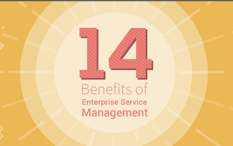The growth of ESM and the driving forces behind it
Service Management has emerged as a highly effective business model for delivering value to customers either directly or through the internal operations of a company. It takes the value-chain concept and orients it from a customer centric perspective – enabling the use of supplier eco-systems, LEAN approaches to efficiency and continuous improvement methodologies for quality to be applied effectively as tools to increase value and productivity. The overall idea of ESM is to:
- Improve process efficiency within the individual functions that contribute to a service to keep the cost of delivery as low as possible without compromising quality
- Reduce the friction that often occurs between departments, so services can be delivered in a coordinated way.
- Increase the consistency and predictability of service delivery
These driving ambitions behind enterprise service management are the same forces that have led to operations management breakthroughs in the areas of Manufacturing (LEAN, Six Sigma and TQM), Information Technology (ITIL, TOGAF, CMMI, Agile, etc.), and other business disciplines over the past few decades. While the scope is different, the ambition is the same.
What we know as ESM today has largely evolved from the field of IT Service Management (ITIL specifically) as companies seek to leverage best practices to solve new and emerging problems.
Service management emerged as a general concept and discipline back in the 1980’s when the British government found that many of the IT services it built and purchased were not meeting organizational expectations. They commissioned the development of a set of methods and standards to enable IT services to be delivered with better quality and lower costs.
This work evolved into a set of standards and best practices which have evolved into the IT Infrastructure Library (ITIL) standards that continue as the benchmark for service management today. Although ITIL has evolved somewhat and been updated over the past 30+ years, its core concepts have remained stable and the advice it provides is widely adopted by most present-day IT organizations.
ITIL was developed specifically to support the IT function and has some very technical components that aren’t applicable outside IT. However, the service management concepts that ITIL describes have been found to be widely applicable to non-IT functions within the enterprise as well. Things like understanding the needs of customers and having a structured set of methods in place for offering and managing services that fulfill those needs.
As ITIL grew in popularity companies realized that ITIL and ITSM best practices could add value outside of the IT function and IT companies. Some of these examples included healthcare, HR, legal function and finance services. In addition to the concepts being transferrable, ITIL compatible tools for things like helpdesk management, knowledge management and self-service were found to provide capabilities that business functions needed to enable productivity.
With concepts, processes and supporting tools becoming more widely adopted across the enterprise (in consistent ways), the concept of Enterprise Service Management emerged as a more holistic way of looking at the capabilities that organizations were implementing.
Modern trends such as “Digital Transformation of Business” are continuing to fuel the growth of ESM in modern organizations – addressing the operational challenges associated with business processes and technology components that are highly dependent on each other.
While ESM grew from the service management roots that were planted in ITIL to address the necessities of managing technology infrastructure, companies are now harvesting its fruits to feed a hunger for innovation and a demand for greater efficiency in the delivery of services to customers.














